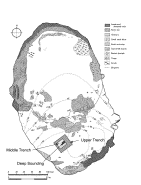Christine Lane , Rainer Grün , Lucy Farr , Chris Hunt, Robyn H. Inglis, Tim Reynolds, Paul Albert, Maxime Aubert, Victoria Cullen, Evan Hill, Leslie Kinsley, Richard G. Roberts, Emma L. Tomlinson, Sabine Wulf, Graeme Barker
Source - http://www.sciencedirect.com/science/article/pii/S0047248413002261
Journal of Human Evolution:Volume 66, January 2014, Pages 39–63
Abstract
The 1950s excavations by Charles McBurney in the Haua Fteah, a large karstic cave on the coast of northeast Libya, revealed a deep sequence of human occupation. Most subsequent research on North African prehistory refers to his discoveries and interpretations, but the chronology of its archaeological and geological sequences has been based on very early age determinations. This paper reports on the initial results of a comprehensive multi-method dating program undertaken as part of new work at the site, involving radiocarbon dating of charcoal, land snails and marine shell, cryptotephra investigations, optically stimulated luminescence (OSL) dating of sediments, and electron spin resonance (ESR) dating of tooth enamel. The dating samples were collected from the newly exposed and cleaned faces of the upper 7.5 m of the ∼14.0 m-deep McBurney trench, which contain six of the seven major cultural phases that he identified. Despite problems of sediment transport and reworking, using a Bayesian statistical model the new dating program establishes a robust framework for the five major lithostratigraphic units identified in the stratigraphic succession, and for the major cultural units. The age of two anatomically modern human mandibles found by McBurney in Layer XXXIII near the base of his Levalloiso-Mousterian phase can now be estimated to between 73 and 65 ka (thousands of years ago) at the 95.4% confidence level, within Marine Isotope Stage (MIS) 4. McBurney's Layer XXV, associated with Upper Palaeolithic Dabban blade industries, has a clear stratigraphic relationship with Campanian Ignimbrite tephra. Microlithic Oranian technologies developed following the climax of the Last Glacial Maximum and the more microlithic Capsian in the Younger Dryas. Neolithic pottery and perhaps domestic livestock were used in the cave from the mid Holocene but there is no certain evidence for plant cultivation until the Graeco-Roman period.

Figure 3.
The McBurney (1967) plan, showing the Upper and Middle Trenches (our terms, not McBurney's) and the Deep Sounding. The original plan, including the relative contour heights of the cave surface before excavation, was in feet as shown here, but a metre scale has been added (Drawing: D. Kemp).

Figure 5.
The new (CPP) excavations in the Haua Fteah: (a) the eastern part of the north-facing section of the Middle Trench, looking south; the visible holes are the locations of OSL tubes; scale in 0.5 m divisions: (b) looking southwest across the Middle Trench to the Trench M excavation in 2012; the second plywood sheet to the left of the standing figure covers the part of the Middle Trench wall shown in the left image; the north-facing and east-facing walls of the Upper Trench are visible in front and to the right (compare the latter with the same face in 1955: Fig. 4a). The large boulder near the top of the north-facing section of the Middle Trench, between the two plywood sheets to the left of the standing figure, is visible in the 1955 photograph shown as Fig. 4a (Photographs: G. Barker).

Figure 7.
Photomicrographs showing the main sediment types within the Haua Fteah as observed through micromorphology: (a) Sample HF09-2155, Microfabrics 3 and 4, XPL: detail of burning event in Facies 5 showing interpreted ash dump (Ash) over crust of clay-rich (Cr) material potentially laid down by an inwash of clay-rich material during a period of hearth disuse; (b) Sample HF08/09-2033, Microfabric 3, PPL (plane polarized light): fine homogeneous silt (Ae) with sand-sized limestone éboulis interpreted as the result of continued aeolian reworking of material within the cave and in the immediate cave surroundings; note thin clay crust (Cr) interpreted as a small-scale wash event – larger lenses in Facies 4 visible in section are interpreted as larger scale wash events, perhaps from outside the cave; (c) Sample HF08-762, Microfabric 1, XPL: clay-rich fabric with stipple-speckled to mosaic b-fabric (the appearance of the fine material under cross polarised light) interpreted as reworked soil material deposited in a mass colluvial movement; clay coating to vegetal void (Co); (d) Sample HF09-2621, Microfabric 3, XP: calcite-cemented unit interpreted as resulting from water dripping or flowing onto sediments; precipitation of crystals in voids has produced platy microstructure similar to that observed in fabrics that have undergone freeze-thaw processes (Analysis by R. Inglis; descriptive terminology following Stoops, 2003).